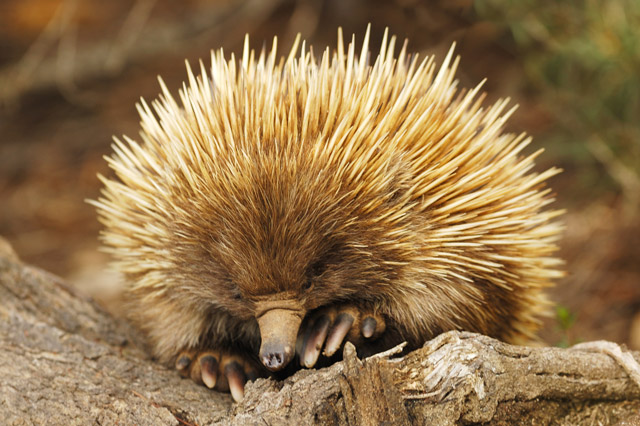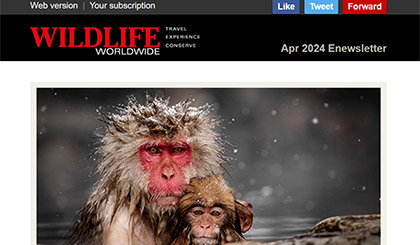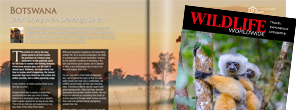Wildlife of South Australia
Anna Scrivenger takes a wild wander through regional South Australia…
Immobilised by wonder, I gaze down at the most peculiar animal ever to take an interest in my foot. A long, black nose protrudes from a mass of thick spines about twice the size of a hedgehog and sniffs at my walking boot. To this echidna, it’s just another obstacle on the rocky coastal heathland that we’re both exploring.
 Well, I can see why they call Kangaroo Island a wildlife Mecca. This beguiling creature is a monotreme – related to neither hedgehog nor porcupine – and one of many endemic creatures to survive here, protected from mainland pressures by the swirling Southern Ocean. The echidna is a unique, insect-snatching animal with a few tricks up its thorny sleeve: for one, both males and females can form a pouch in which to carry their young, simply by contracting their abs. So, to tell a male from a female, you have to get past those spines and feel the soft underbelly. I’m not about to attempt that though, and instead watch it amble calmly into the scrub.
Well, I can see why they call Kangaroo Island a wildlife Mecca. This beguiling creature is a monotreme – related to neither hedgehog nor porcupine – and one of many endemic creatures to survive here, protected from mainland pressures by the swirling Southern Ocean. The echidna is a unique, insect-snatching animal with a few tricks up its thorny sleeve: for one, both males and females can form a pouch in which to carry their young, simply by contracting their abs. So, to tell a male from a female, you have to get past those spines and feel the soft underbelly. I’m not about to attempt that though, and instead watch it amble calmly into the scrub.
MARSUPIAL ISLAND
Kangaroo Island lies 12 kilometres from the coast of South Australia, or 110 kilometres south-west of the capital, Adelaide – from whence it's an easy 30-minute flight or a three-hour drive including a 45-minute ferry ride. There are relatively few human residents here to take advantage of its crashing waves, long beaches and seductive sunsets. Instead, Australia’s third-largest island is largely left to the wildlife.
 As the name suggests, it’s big on wild kangaroos, with its own chocolate-brown endemic subspecies, as well as a population of thigh-high tammar wallabies. Bustling colonies of sea lions loll on beaches (and fur seals on rocky outcrops – just follow your nose!). Whales pass by in winter, dolphins commonly frolic offshore year round, and the island has 50 plant species found nowhere else on Earth. But it’s the colourful collection of 268 bird species that make Kangaroo Island South Australia’s top birding destination.
As the name suggests, it’s big on wild kangaroos, with its own chocolate-brown endemic subspecies, as well as a population of thigh-high tammar wallabies. Bustling colonies of sea lions loll on beaches (and fur seals on rocky outcrops – just follow your nose!). Whales pass by in winter, dolphins commonly frolic offshore year round, and the island has 50 plant species found nowhere else on Earth. But it’s the colourful collection of 268 bird species that make Kangaroo Island South Australia’s top birding destination.
 The black swan, an Aussie icon, abounds here. In the December heat they flock into the estuaries as freshwater wetlands dry up. In autumn, glossy black cockatoos start browsing tree-hollows for their winter nesting season, and Cape Barren geese turn up to breed. As winter ends, hundreds of thousands of shearwaters pass through, riding the air currents above the ocean. Watch from the cliffs and while you’re there, look out for the eight species of albatross recorded here.
The black swan, an Aussie icon, abounds here. In the December heat they flock into the estuaries as freshwater wetlands dry up. In autumn, glossy black cockatoos start browsing tree-hollows for their winter nesting season, and Cape Barren geese turn up to breed. As winter ends, hundreds of thousands of shearwaters pass through, riding the air currents above the ocean. Watch from the cliffs and while you’re there, look out for the eight species of albatross recorded here.
It’s a large island and you’ll need at least a few days to see the highlights. As well as the wildlife there’s rugged coastline, wild scenery, and local produce to try with artisan wines.
COLOURFUL CAST
The island gives a thriving snapshot of South Australia’s wildlife, but its capital, Adelaide, is a gateway to even more unforgettable nature, in every direction. Just across the Spencer Gulf for example, lies the Eyre Peninsula,
 where rugged coastline attracts a wealth of marine life. It’s a great place to watch whales, swim with wild dolphins and seals, snorkel with colour-changing giant cuttlefish and even get face-to-face with fearsome great white sharks (from the safety of a cage). The Eyre Peninsula is also famed for its seafood. Eating out in Port Lincoln, on its southern tip, is a must. Specialities hauled daily from the ocean include southern bluefin tuna and yellowtail kingfish, along with Pacific oysters, mussels, prawns, abalone and blue swimmer crab.
where rugged coastline attracts a wealth of marine life. It’s a great place to watch whales, swim with wild dolphins and seals, snorkel with colour-changing giant cuttlefish and even get face-to-face with fearsome great white sharks (from the safety of a cage). The Eyre Peninsula is also famed for its seafood. Eating out in Port Lincoln, on its southern tip, is a must. Specialities hauled daily from the ocean include southern bluefin tuna and yellowtail kingfish, along with Pacific oysters, mussels, prawns, abalone and blue swimmer crab.
TOWARDS THE CENTRE
If your tastes are more terrestrial, South Australia’s outback regions boast their own regional specialties. Emu-egg omelettes, camel steak in native-thyme butter and sweet quandong (native peach) pie are good rewards for a bit of bushwalking. So, for a contrast to the coast, head north to Wilpena Pound, a whorl of ancient sandstone ridges rising from the flat Outback. It's a five-hour drive from Adelaide and merits a couple of days’ exploring. You can connect from Adelaide by light aircraft if you prefer, but it also forms part of an incredible road trip into the outback. 4WD safari tours serve the area, but bring sturdy footwear for bushwalking, too – you’ll soon see why this is a very popular spot for it. Here, 800 million-year-old rock walls harbour a crucible of flora and fauna. Stand still and you can hear nothing but the timeless hum of life, bound up with a traditional culture – it’s been a meeting place for the Adnyamathanha people for many thousands of years, and you may stumble upon their ancient rock art.
 Among reed-filled waterholes and weathered ochre rocks that change colour with the light, look out for yellow-footed rock wallabies amid the boulders, sought by wedge-tailed eagles gliding high overhead. It’s joined here by euro wallaroos and larger kangaroos, as well as mouse-size marsupials called dunnarts which depend on the spinifex. This feels a long way from the cafés of Adelaide – or from humanity in general. South Australia is wild, wide-open and alive with all sorts of wildlife from squawking parrots to huge emus, desert goannas to leaping whales. Use Adelaide as the base to explore it all though, and you’re set for the wildest adventure under the Southern sky.
Among reed-filled waterholes and weathered ochre rocks that change colour with the light, look out for yellow-footed rock wallabies amid the boulders, sought by wedge-tailed eagles gliding high overhead. It’s joined here by euro wallaroos and larger kangaroos, as well as mouse-size marsupials called dunnarts which depend on the spinifex. This feels a long way from the cafés of Adelaide – or from humanity in general. South Australia is wild, wide-open and alive with all sorts of wildlife from squawking parrots to huge emus, desert goannas to leaping whales. Use Adelaide as the base to explore it all though, and you’re set for the wildest adventure under the Southern sky.
SOUTH AUSTRALIA’S STAR SPECIES
And where to see them...
KANGAROO ISLAND
-
 Hooded plover: Patrols the receding tide on sandy beaches, picking out tiny invertebrates. Adults have black head and collar, and red legs.
Hooded plover: Patrols the receding tide on sandy beaches, picking out tiny invertebrates. Adults have black head and collar, and red legs. - Cape Barren goose: A stout and striking goose with short, black-tipped yellow bill and red legs –native to southern Australia and New Zealand. .
- Glossy black cockatoo: Kangaroo Island has evolved its own subspecies of this Pacific-coast bird. It claws apart the cones of casuarina (she-oak) trees, to extract seeds with its tongue.
FLINDERS RANGES
- Elegant parrot: A handsome 20 centimetre parrot with lime and gold down and bright and dark blue flight feathers.
 Look for the two-tone blue band across its forehead (more pronounced in males).
Look for the two-tone blue band across its forehead (more pronounced in males). - Short-tailed grasswren: Found only here and in the Gawler Ranges further west, this spinifex-dependent little brown bird perches with its tail aloft.
- Wedge-tailed eagle: Also known as the bunjil or eaglehawk, this is Australia’s largest bird of prey: formidable, with chocolatey plumage, very long feathered legs and a distinctive wedge tail. Nests in trees and will hunt almost anything.
EYRE PENINSULA
-
 Western whipbird: A coastal lagoon wader with white body, black wings and bib and red legs.
Western whipbird: A coastal lagoon wader with white body, black wings and bib and red legs. - Blue-breasted fairywren: Flies all the way from Siberia, crossing two vast continents to join other migrating shorebirds here.
- Rufous treecreeper: A tree-dweller who nonetheless likes eating ants off the ground. About 15 centimetres long with colourful copper head and underparts.
Explore our range of expert led tailor-made tours to experience South Australia’s wildlife and birding hotspots.








